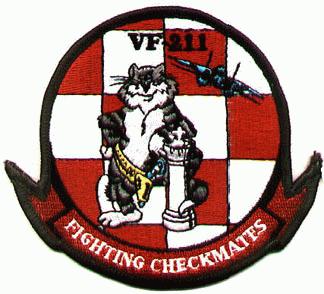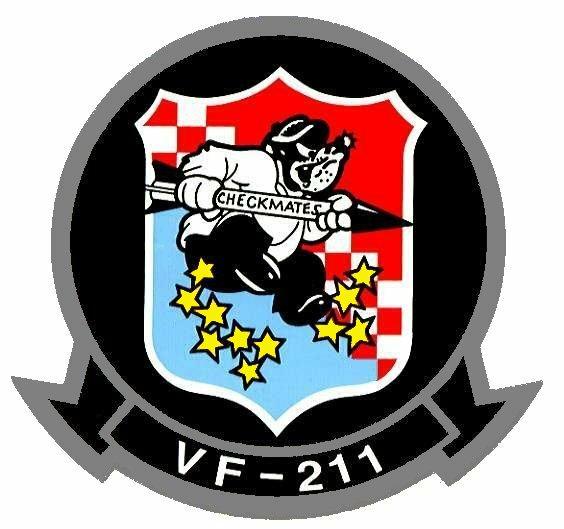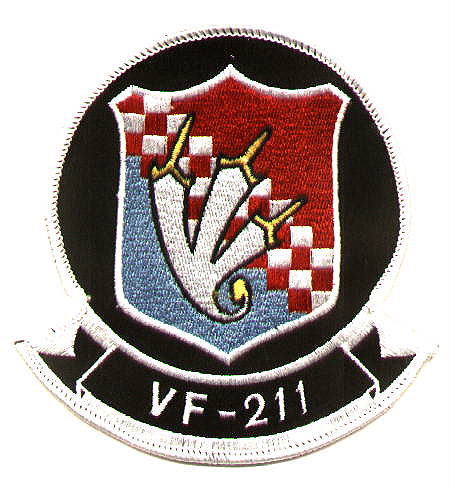VF-211 Squadron History
VF-211 Fighting Checkmates
Base:NAS Oceana
Callsign:'Nickel'
Tailcode:'NG'
Variant:F-14A
VF-211's origins trace back to VB-74, which was established upon the
1st of May 1945. The squadron acquired it's present designation on the
9th of March 1959. Before receiving the F-14A Tomcat VF-211 flew the
Navy's last all gun fighter, the famous F-8J Crusader, becoming widely
known due to their attractive and visible markings. However, the
Crusader's days were number after the 23rd of December 1975, when
VF-211 made it's maiden flight in the, at that time, brand new and
highly advanced F-14A. VF-211 was the ninth squadron to receive the
F-14A, following VF-124, VF-1, VF-2, VF-14, VF-32, VF-142, VF-143,
and VF-114. Within six months VF-211 was flying the F-14A in that most
difficult of Navy arts: carrier landings, the first taking place on the
USS Constellation (CV-64) in June of 1976. The squadron's first cruise
(with VF-24 as part of CVW-9) was also on board Constellation,
beginning in April of 1977. Regular cruises on board Constellation
followed, until in October 1980 VF-211 was selected to pick up the
reconnaissance mission, with the "interim" TARPS pod. The original
plans envisaged the introduction of a recon version of the F/A-18
Hornet within a few years, but VF-211 (and the rest of the F-14
community) are still performing this vital mission today.
July of 1983 saw the first cruise on board another carrier, as CVW-9
shifted to the USS Ranger (CV-61), due to the USS Constellation going
into the Naval Shipyard at Bremerton to have a refit and update that
would install the F/A-18 avionics and maintenance areas. VF-211 shifted
again in 1985, this time to the USS Kitty Hawk so that Ranger could
have the F/A-18 update. The Kitty Hawk cruise lasted from July to
December of 1985. After this cruise VF-211 renewed it's association with
the Constellation, then in early 1987 moved to the Kitty Hawk again,
being aboard from January to June 1987. Following this cruise the whole
of CVW-9 moved to the USS Nimtz (CVN-68), newly transferred from
the Atlantic fleet.
In 1986 VF-211 took part in trials of experimental water based
camouflage schemes, painting at least four aircraft in temporary schemes
that consisted of browns and greys, three different shades of each
colour being used. These paint schemes were found to weather fairly
quickly and on different aircraft the underlying TPS greys and
squadron markings could be seen to differing extents. The paint took
around four hours to apply and ten to remove, resulting in some of the
most interesting F-14 schemes to date.

|
VF-211 started to receive the upgraded F-14A+ (now F-14B) in April
of 1989, for the first time being able to fly the F-14 to it's aerodynamic
limits rather than it's engine limits. While VF-211, as with most Navy F-
14 units, may well have been eagerly looking forward to receiving the
vastly superior F-14D, this was not to be. With the end of the Cold
War and changing requirements the Secretary of Defence, Dick Cheney,
halted all production of the F-14D, after only 55 had been produced.
Instead, in 1992, VF-211 was forced to return to the F-14A, due to a
decision to shift all F-14B's to Atlantic Fleet units.
VF-211 has received training for air to ground weapons and now
routinely flys sorties with the aircraft primarily configured for air to
ground attack, which while part of the original Navy specification for
the F-14, was a capability which for a long time was left untapped. VF-
211 has received LANTIRN capable F-14's in small numbers, but the present lack of pods
means they are not fully operative in the LANTIRN roles. The squadron left NAS Miramar in
August of 1996, and is now settled in it's new home at NAS Oceana.
When required for cruises, all squadrons assigned to west coast
carriers will now fly across the USA, but for administrative reasons will
be under the command of COMNAVAIRLANT.

VF-211 Insignia Courtesy of LCDR Dave Baranek
|
VF-211 deployed onboard the USS Nimtz in September 1997, taking 10 aircraft and several LANTIRN pods.
The cruise became even more eventful than normal whne Saddam hussein expelled UN weapon inspectors
from Iraq. The resulting crisis saw a large build up of forces in the Gulf, assisting CVW-9, who had
already been present, enforcing the Southern Watch No-Fly Zone. As tension rose the F-14's of VF-211
proved invaluable. In the event the forces gathered in the Gulf were not used, but proved again an important
lesson regarding carriers-you don't need anyone else's permission to use it. The Checkmates, despite having
been in theatre for several months took up the extension of the cruise without complaint, flying daily missions
until the crisis was resolved. They even had time to paint an aircraft with the squadron mascot Bluto (seen
on a patch to the right), a tradition whenever the Fighting Checkmates spend Christmas away from home.
After the long cruise the welcome back to Oceana in Janaury 1998 was even better than usual. After the normal
stand down VF-211 restarted flight ops and in the period since have sent jets to NAS Fallon and the NAS
Norfolk airshow, in addition to normal flying.
The next cruise date is uncertain, but whenever it comes the Fighting Checkmates of VF-211 will be ready.
As mentioned above, during the 1970's VF-211 had some of the most
visible markings around and even in the present era are some of the
most attractive in the F-14 community. Today's VF-211 markings feature
dark grey checks upon the rudder, twin dark grey horizontal lines at
the top and bottom of the tailfin and the NG tailcode in small letters.
Aircraft from the squadron are often seen with a black/dark grey anti-
glare panel that continues along the cockpit and down the spine of the
aircraft. A second thin stripe is often used to highlight this area.
The images below show the first steps in the move from hi-vis to low-vis
markings for VF-211. The first shows a VF-211 aircraft in the early gull grey/white camouflage scheme,
with very hi-vis markings. The coloured stars on the tail represent the squadrons assigned to CVW-9.
Image Courtesy of Torsten Anft
In this second image the white has gone from the camouflage and the tailcode has reduced in size.
Later changes would see the red, white and blue tail markings replaced with grey, as would be the blue canopy hood and the red underfuselage strake.
Image Courtesy of Torsten Anft
VF-211 Fighting Checkmatesí Aircraft Tail Design, 1996-1998
From the time we began flying Tomcats in 1975, the Fighting Checkmates painted our aircraft
tails with checkerboard rudders, horizontal stripes at top and bottom of rudders, and the air
wing letters, NG. Around the canopy we painted a dark anti-glare panel, known as a "bandit
stripe." Several people have asked about recently seen changes, so I offer the following
comments.
In July 1996, outgoing Commanding Officer CDR Gerry Beaman announced at his change of command
that he was adding a "check-mark" to the center of the tail. This served two purposes:
Honored the soon-to-decommission Fighting Renegades of VF-24, long-time sister squadron of
VF-211. Many VF-24 personnel joined VF-211 to complete their prescribed sea duty. VF-24
decommissioned in August 1996.
Recalled one of the tail designs VF-211 had used while flying F-8 Crusaders in the 1960s.
Each squadron was allowed to paint 2 aircraft in color. On these aircraft the check-mark was red,
outlined in dark blue; the horizontal stripes were red, white, and dark blue; rudder checkerboards
were red and white. The bandit stripe was dark blue. On the remainder of our aircraft, the
markings were dark gray. We painted NG100 and NG101 in color; some photos show other side numbers
in color, since side numbers occasionally changed as aircraft were transferred in or out of the
squadron.
The next C.O., CDR J. D. Oliver, did not change the tail design during his tour as C.O.
Shortly after I became C.O. in August 1997 we went on deployment. In September I directed that
the check-mark be removed, so the design reverted to VF-211ís traditional Tomcat design. Since
the squadron was deployed during the Christmas Holidays, we painted a Christmas-theme design on
the tails of NG101. During the 1995-96 deployment this had been "the Grinch" cartoon character.
For 1997-98, it was the character from squadron logo, dressed in a Santa Claus suit. Noting the
high quality of this tail design (applied by AMSAN Mike Kreisher, under the supervision of AMS1
Patricia Shannon), I directed that the character from the squadron logo be applied to NG101ís
tails upon return from deployment.
In March 1998 COMFIT-WINGLANT further standardized paint schemes on Tomcats, eliminating anti-glare
panels and limiting squadrons to painting one aircraft in color. Many squadrons painted their
"CAG bird" in color, but I had my jet (NG101) painted in color, with the logo character.
CDR David Baranek, USN
July 1998
| BuNo. | Modex (late 96) | Modex (20/05/98) |
| 160389 | 104 |
| 160892 | 114 |
| 160913 | 107 |
| 160920 | 102 |
| 161141 | 101 |
| 161271 | N.P. | 112 |
| 161274 | N.P. | 102 |
| 161282 | 103 |
| 161288 | 111 |
| 161294 | N.P. | 100 |
| 161600 | 110 |
| 161611 | 113 |
| 161615 | 116 |
| 161853 | 105 |
| 161856 | N.P. | 101 Bluto |
| 162588 | 100 | |
| 162598 | 115 |
| 162600 | 106 | 106 |
20/05/98 data is not a complete listing.
[Main Page]
[F-14A]
[F-14B]
[F-14D]
[Tomcat 21]
[Atlantic Fleet Squadron Histories]
[Pacific Fleet Squadron Histories]
[F-14A Images]
[F-14B Images]
[F-14D Images]
[F-14 Model Kits]
[US Navy Air Wings]
[A-6 images]





